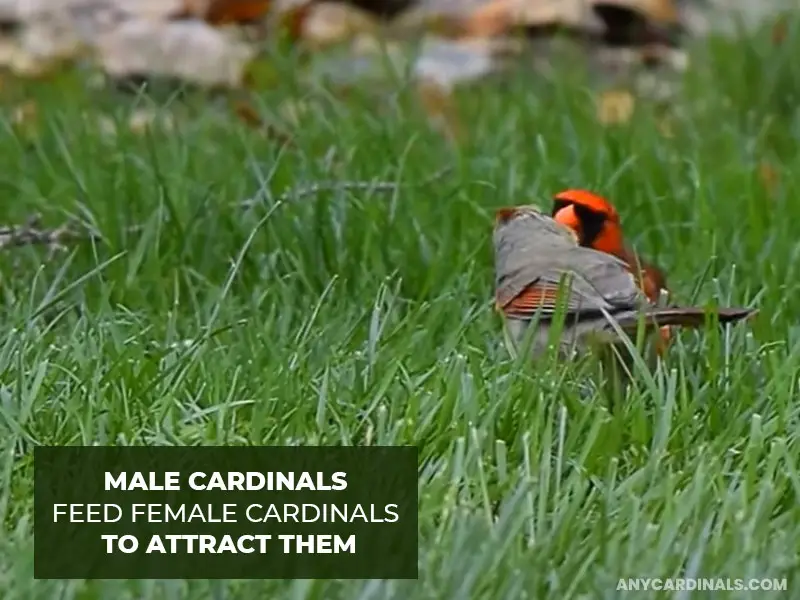How Do Cardinals Mate? Secrets Behind Their Lifelong Monogamy
Cardinals’ behaviors have always drawn the attention of many birders and ornithologists and made them think about cardinals’ various traits, such as how do cardinals mate? If you also want to know the answer, here you go:
After pairing up and building the nests, cardinals prepare for mating, which begins with rubbing their cloacal openings for seconds. Then, sperms release from the male’s body and enter the female’s body, ending the cardinals’ mating process.
Quite interesting, right? But how cardinals find and flirt with their mates is even more engrossing. Let’s read further to know about this fact in detail.
Related blog about cardinals behavior:
How Do Cardinals Find Their Mates?
Cardinals start finding their mates at the beginning of the mating season. The process of choosing mates is both fun and exciting for these stunning monogamous birds.

Like other birds, male cardinals’ job is to pursue females to form a family. Male cardinals accomplish this task by performing various courtship rituals, including singing, dancing, and feeding. Below, we have briefly described the courtship behaviors.
01. Singing & Dancing
Singing and dancing are significant parts of the cardinals’ courtship ritual. Male cardinals produce melodious songs to lure their mates. Not only that, but they also dance at the same time.
They shake their tails and shift their bodies from side to side using their legs while singing in a high-pitched tone. You can say that’s how male cardinals flirt with females.
This synchronized singing and dancing, often called “counter-singing,” involves males and females responding to each other’s calls to strengthen pair bonds, as noted by the Cornell Lab of Ornithology.
02. Displaying Plumage
Female cardinals get easily flattered by male cardinals with strikingly red-colored feathers. They consider such males to be strong and protective and can feed their families for a prolonged duration.
Thus, before pairing up with male cardinals, females inspect male cardinals’ beaks, face masks, and plumage colors.
That means the vibrancy of male cardinals’ feathers can favor them in getting their mates. And thus, male cardinals always exhibit their feathers by spreading wings to lure their mates.
Bright red plumage signals high testosterone levels and good health, making males more attractive to females.
03. Feeding Would-Be Mates
Male cardinals feed female cardinals to attract them. It’s another adorable gesture involved in the courtship ritual. Male cardinals pick seeds using their beaks and move towards female cardinals and feed those seeds to females by touching each other’s beaks.

This sweet mate-feeding behavior is widely known as the cardinal kiss in the bird watchers community. So, that’s all the courtship rituals cardinals apply to attract their mates.
This feeding, or allofeeding, demonstrates the male’s ability to provide resources, crucial for female reproductive success.
Other Essential Information On Cardinals’ Mating:
Below, we have shared necessary information regarding cardinals’ mating in question-answer format to help you comprehend this topic entirely. So, let’s read on.
What Months Do Cardinals Mate?
Cardinals’ mating season starts in March and runs through September. They raise two broods each breeding period; one at the beginning of March and the other in late May to July.
Clutch sizes typically range from 2-5 eggs, with females incubating for 11-13 days before hatching.
Do Cardinals Stay With The Same Mate?
Cardinals are monogamous, and they mate for life. That means cardinals stay with the same mates and tend not to leave their partners. However, if one cardinal of the pair loses its mate, it will choose another mate.

Besides, if one cardinal fails to deliver satisfying results in reproduction, the other cardinal of the pair will choose a different partner.
This lifelong monogamy is reinforced by shared territory defense, enhancing their breeding success.
What Age Do Cardinal Mate?
Cardinals have a short lifespan of three years. Hence they grow quickly, and both male and female cardinals become sexually mature when they are one year old. After hitting maturity, cardinals can mate.
Sexual maturity coincides with their first full molt, when males develop vibrant red plumage.
What Sound Do Cardinals Mate?
Male and female cardinals communicate through calls during mating. According to avian experts, their mating calls sound like psst.
These short, sharp calls are often accompanied by softer chirps to coordinate mating activities.
What Birds Do Cardinals Mate With?
As you know, cardinals are monogamous and will adhere to the same mates for life. They won’t mate with other birds, nor do they even mate with other cardinals except for their chosen pairs.
Their strict species-specific mating prevents hybridization, maintaining genetic purity.
Do Cardinals Mate With Other Birds?
No, cardinals don’t mate with other birds, and Cardinals always choose other cardinals as their lifelong partners and tend not to leave their mates.
This behavior ensures strong pair bonds, critical for raising multiple broods each season.
How Long Do Cardinals Mate For?
If you are talking about their copulation’s duration, the answer is that it lasts only for seconds following the cloacal kiss. But the period may extend to 9 days if we consider the entire mating process from nest building to copulating.
The cloacal kiss, or cloacal contact, is brief but repeated over several days to ensure fertilization.
Tips for Observing Red Cardinal Mating Behaviors
Best Times: Watch in early spring (March-April) to see courtship displays like singing and feeding.
Binoculars: Use binoculars to observe nest-building and mate-feeding without disturbing them.
Location: Focus on dense shrubs or low trees where they build nests.
Distance: Stay at least 20 feet away to avoid disrupting their courtship rituals.
Wrapping Up:
People, especially couples, admire cardinals as these birdies are flag-bearers of monogamy. Although monogamy is close to extinction in our society, it is prevalent in the cardinal’s community. They teach us how to live with the same mate for life and how to take care of the family.
We hope now you know everything about the cardinals’ mating traits. We tried to gather all related information in this content to quench your thirst for knowledge. If our effort helps you, you may share this article on Twitter & Pinterest as appreciation.
Image Credits:
- YouTube.com (My Backyard Friends)
- Canva.com/Photos

